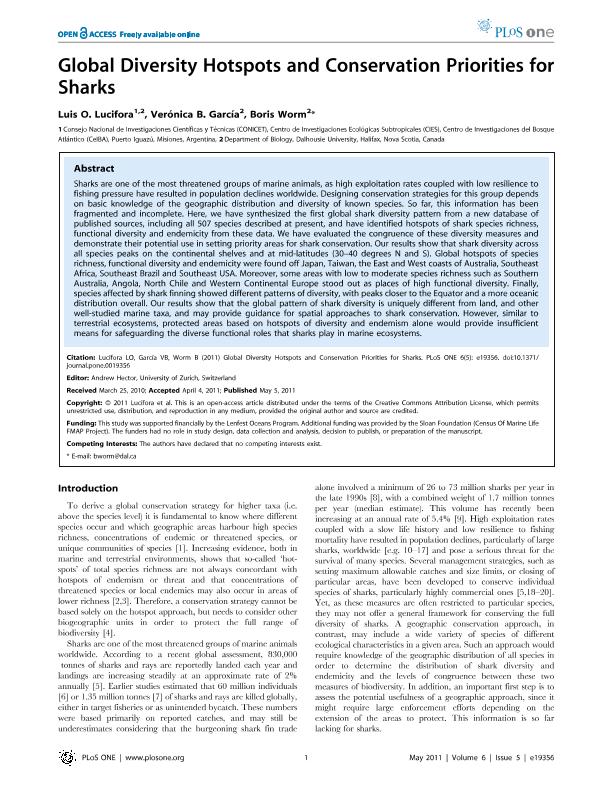Mostrar el registro sencillo del ítem
dc.contributor.author
Lucifora, Luis Omar

dc.contributor.author
García, Verónica Beatriz

dc.contributor.author
Worm, Boris
dc.date.available
2019-07-11T19:27:27Z
dc.date.issued
2011-05
dc.identifier.citation
Lucifora, Luis Omar; García, Verónica Beatriz; Worm, Boris; Global Diversity Hotspots and Conservation Priorities for Sharks; Public Library of Science; Plos One; 6; 5; 5-2011; 1-7
dc.identifier.issn
1932-6203
dc.identifier.uri
http://hdl.handle.net/11336/79391
dc.description.abstract
Sharks are one of the most threatened groups of marine animals, as high exploitation rates coupled with low resilience to fishing pressure have resulted in population declines worldwide. Designing conservation strategies for this group depends on basic knowledge of the geographic distribution and diversity of known species. So far, this information has been fragmented and incomplete. Here, we have synthesized the first global shark diversity pattern from a new database of published sources, including all 507 species described at present, and have identified hotspots of shark species richness, functional diversity and endemicity from these data. We have evaluated the congruence of these diversity measures and demonstrate their potential use in setting priority areas for shark conservation. Our results show that shark diversity across all species peaks on the continental shelves and at mid-latitudes (30-40 degrees N and S). Global hotspots of species richness, functional diversity and endemicity were found off Japan, Taiwan, the East and West coasts of Australia, Southeast Africa, Southeast Brazil and Southeast USA. Moreover, some areas with low to moderate species richness such as Southern Australia, Angola, North Chile and Western Continental Europe stood out as places of high functional diversity. Finally, species affected by shark finning showed different patterns of diversity, with peaks closer to the Equator and a more oceanic distribution overall. Our results show that the global pattern of shark diversity is uniquely different from land, and other well-studied marine taxa, and may provide guidance for spatial approaches to shark conservation. However, similar to terrestrial ecosystems, protected areas based on hotspots of diversity and endemism alone would provide insufficient means for safeguarding the diverse functional roles that sharks play in marine ecosystems.
dc.format
application/pdf
dc.language.iso
eng
dc.publisher
Public Library of Science

dc.rights
info:eu-repo/semantics/openAccess
dc.rights.uri
https://creativecommons.org/licenses/by/2.5/ar/
dc.subject
Elasmobranch
dc.subject
Conservation
dc.subject
Diversity
dc.subject
Protected Areas
dc.subject.classification
Conservación de la Biodiversidad

dc.subject.classification
Ciencias Biológicas

dc.subject.classification
CIENCIAS NATURALES Y EXACTAS

dc.title
Global Diversity Hotspots and Conservation Priorities for Sharks
dc.type
info:eu-repo/semantics/article
dc.type
info:ar-repo/semantics/artículo
dc.type
info:eu-repo/semantics/publishedVersion
dc.date.updated
2019-06-11T13:32:47Z
dc.journal.volume
6
dc.journal.number
5
dc.journal.pagination
1-7
dc.journal.pais
Estados Unidos

dc.journal.ciudad
San Francisco
dc.description.fil
Fil: Lucifora, Luis Omar. Consejo Nacional de Investigaciones Científicas y Técnicas. Centro Científico Tecnológico Conicet - Nordeste; Argentina. Centro de Investigaciones del Bosque Atlántico; Argentina. Dalhousie University Halifax; Canadá. Administración de Parques Nacionales. Parque Nacional "iguazú". Centro de Investigaciones Ecológicas Subtropicales; Argentina
dc.description.fil
Fil: García, Verónica Beatriz. Dalhousie University Halifax; Canadá
dc.description.fil
Fil: Worm, Boris. Dalhousie University Halifax; Canadá
dc.journal.title
Plos One

dc.relation.alternativeid
info:eu-repo/semantics/altIdentifier/url/https://journals.plos.org/plosone/article?id=10.1371/journal.pone.0019356
dc.relation.alternativeid
info:eu-repo/semantics/altIdentifier/doi/https://doi.org/10.1371/journal.pone.0019356
Archivos asociados
